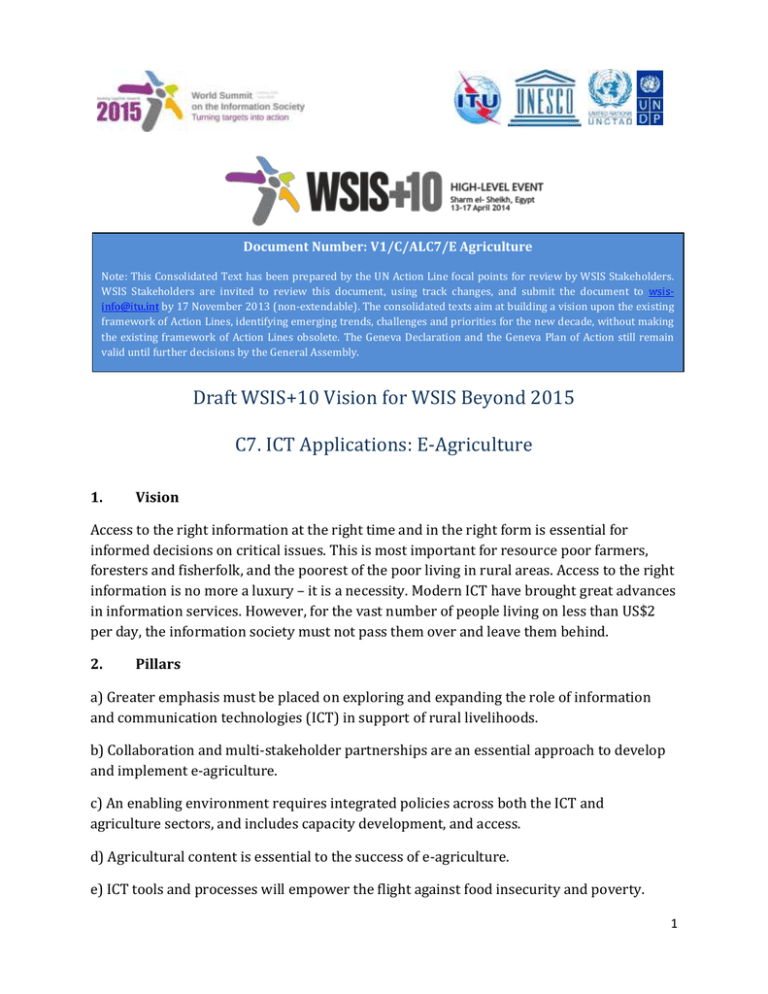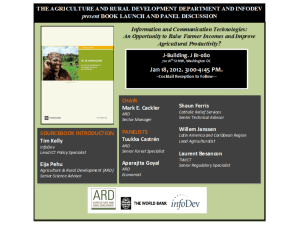Document Number: V1/C/ALC7/E Agriculture
advertisement

Document Number: V1/C/ALC7/E Agriculture Note: This Consolidated Text has been prepared by the UN Action Line focal points for review by WSIS Stakeholders. WSIS Stakeholders are invited to review this document, using track changes, and submit the document to wsisinfo@itu.int by 17 November 2013 (non-extendable). The consolidated texts aim at building a vision upon the existing framework of Action Lines, identifying emerging trends, challenges and priorities for the new decade, without making the existing framework of Action Lines obsolete. The Geneva Declaration and the Geneva Plan of Action still remain valid until further decisions by the General Assembly. Draft WSIS+10 Vision for WSIS Beyond 2015 C7. ICT Applications: E-Agriculture 1. Vision Access to the right information at the right time and in the right form is essential for informed decisions on critical issues. This is most important for resource poor farmers, foresters and fisherfolk, and the poorest of the poor living in rural areas. Access to the right information is no more a luxury – it is a necessity. Modern ICT have brought great advances in information services. However, for the vast number of people living on less than US$2 per day, the information society must not pass them over and leave them behind. 2. Pillars a) Greater emphasis must be placed on exploring and expanding the role of information and communication technologies (ICT) in support of rural livelihoods. b) Collaboration and multi-stakeholder partnerships are an essential approach to develop and implement e-agriculture. c) An enabling environment requires integrated policies across both the ICT and agriculture sectors, and includes capacity development, and access. d) Agricultural content is essential to the success of e-agriculture. e) ICT tools and processes will empower the flight against food insecurity and poverty. 1 f) In order to ensure that a new "digital divide" is not occurring, a special attention must be given to the information needs of and usage by women and young people. 3. Targets a) There is a clear and urgent need for urban-rural disaggregated data (e.g. mobile or broadband penetration, usage data, etc.). b) Accessibility and availability of global public goods (information managed by the public sector), in the context of the digital information society. c) Gender disaggregated data on access and usage. 2 Annex: Zero Draft Stakeholder Contributions 1) Exploring and expanding the role of ICT 1. Greater emphasis must be placed on exploring and expanding the role of ICT to assist farmers, foresters and fisherfolk in developing countries, including services from mobile, fixed line, satellite and broadband technologies. 2) Partnerships 2. Collaboration and multi-stakeholder partnerships are an essential approach to develop and implement e-agriculture strategies, products and services, as well as build capacity. 3) Enabling Environment 3. Systematically integrate ICT policies, content and capacity development into national and regional agricultural policies. 4. Integrate agriculture into national and regional ICT policies. 5. Promote e-agriculture as an efficient mechanism to improve rural areas, in particular to boost entrepreneurship and economic growth. 6. Raise awareness and create ICT tools to enhance agriculture as a way to help development. 7. Reduce the costs associated with information access in rural areas, with the goal of ensuring direct individual access to relevant content for smallholders. 4) Capacity Development 8. Foster digital literacy and provide specialized training for girls and women, people with disabilities, children and young people to overcome illiteracy and/or to improve existing skills. 9. Ensure capacity development occurs at the individual and institutional levels. 10. Develop a capacity assessment framework with clear indicators that are relevant and acceptable. 11. Continue to develop information and experiences sharing networks in the agriculture sector, including the e-Agriculture Community. 12. Make agriculture and related economies knowledge-based economies with ICT and agri-informatics. 5) Content 13. Improve the availability of quality content, including hyper-local information. 14. Facilitate the appropriate digitization of local knowledge, including the know-how of farmers, foresters and fisherfolk. 3 6) Tools and Processes 15. Promote mobile technology and mobile information services as an important tool in agricultural development and business. 16. Develop traceability systems that connect farms to consumers’ tables, providing quality data and securing reliability of our foods. 17. Improve agriculture and food production and management utilizing sensors, cloud computing and other forms of ICT. 18. Facilitate the information flows and social networks that will maximize the positive impact that the ICT can have on the livelihoods of people in rural agricultural communities. 19. Expand upon the success of farmers and business peoples using mobile technology to access real-time data and to sell their crops/produce remotely. 20. Use ICT to enable a value chain that more closely collaborates with producers. 7) Women and Youth 21. There is an urgent need for affordable and quality ICT access providing relevant, quality and actionable content in rural areas, with a particular focus on agricultural smallholders, women and youth. 22. Empower and ensure access for rural women and girls, and youth with the capacity to use ICT in agriculture. 23. Youth must be mentored and encouraged to enhance the agricultural sector through their own ICT innovations. 4




